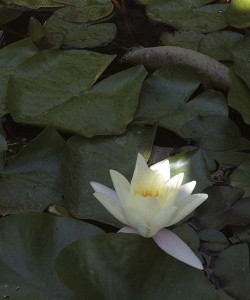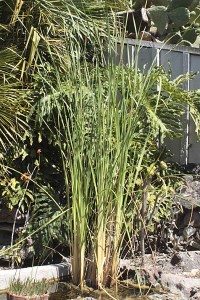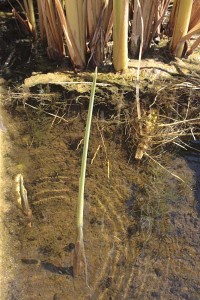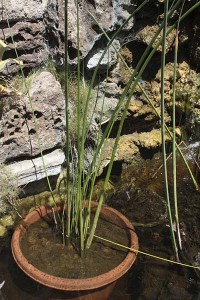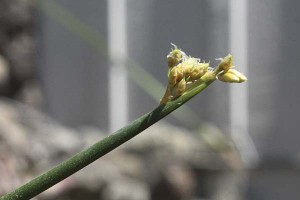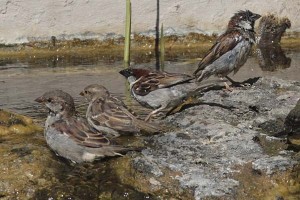When we purchased the house it came with a nice, deep pond that was perfect for waterlilies. It also came with an upper pond with a waterfall into the lily pond, and two other small ponds. Two decades later, one of the small ponds has now been converted into a planter, and another into my bog garden. Remaining are the two largest ponds, the lily pond and the upper pond, which we reduced in size by half.
We’ve had waterlilies blooming since the end of April. I have no idea what variety this one is–It came with the pond that came with the house. But it’s a tough and reliable plant.
The ponds are mostly John’s territory, but I’ve sneaked a couple California native species into them. The first is a cattail (Typha sp.), one of my favorite water plants.
If you’ve ever grown these, you realize quickly that there’s a certain amount of maintenance that goes with them, mainly in dealing with their spreading rhizomes. If the plant is potted, it’ll soon escape and will require frequent trimming when growing actively. Here are a couple of shoots that have escaped into the fertile pond scum. In the past the shoots got tossed, but I just read in an excerpt from Steve Brill and Evelyn Brin’s Identifying and Harvesting Edible and Medicinal Plants in Wild (and Not-So-Wild) Places how they’re totally edible and are nicknamed “Cossack’s asparagus.” The next trimmings will be going into the skillet.
A new native to the pond is California bulrush (Scirpus californicus), a replacement for a giant papyrus that finally succumbed after two decades. Although the new scirpus is called a rush, it’s actually a sedge. Two months ago it was a one-gallon plant. Now it’s easily twice the size.
Its little flowers aren’t spectacular, but a mass of these little bloom clusters could be a nice effect once it gets a little larger.
The closest canyon is about an eighth of a mile away, but various critters find their way to the water. Raccoons, opossums and tracks from a cat larger than a house cat, smaller than a cougar have been sighted over the years. During the first years a couple of visits from a great blue heron finally discouraged John from trying to raise koi in the lower pond after they ended turning in expensive birdfeed.
These days the main visitors are sparrows, which blend so well with pond scum and the surrounding rocks that they’re hard to see…
…and these days we’re seeing a lot of these lesser goldfinches.
Now that our daytime temperatures have finally been climbing into what you’d expect during the summer, I think I might be frolicking in the water if I were one of these birds.

